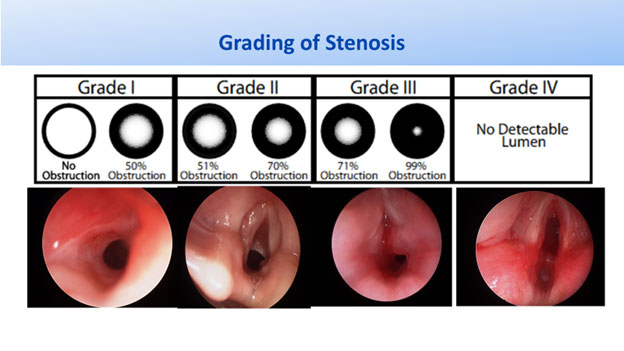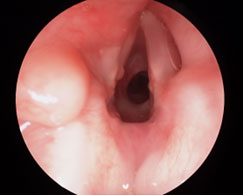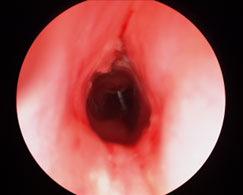Subglottic and
Tracheal Stenosis
Learn about symptoms,
diagnosis, and life-changing
airway surgeries
Discover expert care for subglottic and tracheal stenosis in children. Laryngotracheal reconstruction, Cricotracheal resection, Slide tracheoplasty. Learn about symptoms, diagnosis, and life-changing airway surgeries.
What is Subglottic and Tracheal Stenosis?
Subglottic and tracheal stenosis are conditions where the airway below the vocal cords (subglottis) or within the windpipe (trachea) becomes abnormally narrow, making it difficult for a child to breathe. These conditions can range from mild to life-threatening and often require evaluation and treatment by a pediatric airway specialist.
Causes of Airway Stenosis
Congenital Stenosis
- Present at birth due to underdeveloped or malformed airway cartilage
- May be associated with syndromes or other airway anomalies
Acquired Stenosis
- Most commonly caused by prolonged intubation (breathing tube)
- Can result from trauma, infection, or previous airway surgery
- Sometimes related to autoimmune or inflammatory conditions
Symptoms of Subglottic/Tracheal Stenosis
- Persistent or progressive noisy breathing (stridor)
- Wheezing that doesn’t improve with asthma treatment
- Shortness of breath, especially during activity
- Barking cough or recurrent croup
- Voice changes or weak cry
- Feeding difficulties or cyanosis (blue coloring of lips during crying)
How is It Diagnosed?
Evaluation is led by a pediatric ENT and may include:
Flexible Laryngoscopy – A small camera is used to examine the upper airway.
Direct Laryngoscopy and Bronchoscopy – Performed under general anesthesia to get a detailed look and measure the degree and length of the narrowing.
CT or MRI Imaging – Helps define the airway anatomy and plan surgery.
Airway Grading – Subglottic stenosis is often classified using the Myer-Cotton grading system (Grade I to IV based on severity).

Treatment Options
Treatment depends on the severity, location, and cause of the narrowing. Our goal is to restore safe, stable breathing and avoid long-term tracheostomy whenever possible.
Surgical Treatment Options
Endoscopic Balloon Dilation with laser
- A balloon is inserted and inflated inside the airway to gently widen the narrowed segment.
- Often done as an outpatient procedure, especially in mild to moderate stenosis.
- May need to be repeated over time.

Subglottic Web

Laser incision of the subglottic web
Laryngotracheal Reconstruction (LTR)
- A piece of cartilage (often from the rib) is used to expand the narrowed airway.
- Can be single-stage (without tracheostomy) or double-stage (with temporary tracheostomy).
- Ideal for moderate to severe subglottic stenosis.
Cricotracheal Resection (CTR)
- The most definitive surgery for severe or long-segment subglottic/tracheal stenosis.
- The narrowed part of the airway is surgically removed, and the healthy ends are reconnected.
- Performed by a highly experienced pediatric airway team.
- Often allows for decannulation (removal of tracheostomy) if successful.
Cervical Slide Tracheoplasty
- Advanced technique for long or complex tracheal narrowing
- The narrowed trachea is cut and opened longitudinally, then slid and reconstructed to create a wider and shorter airway
- Often used for complex congenital tracheal stenosis or post-surgical scarring
- Requires expert surgical planning and ICU support
- Often results in excellent long-term airway function
Recovery and Follow-Up
- Most children stay in the hospital for several days to weeks, depending on the surgery.
- Post-operative care may include airway monitoring, feeding support, and speech therapy.
- Some children need repeat airway evaluations or temporary tracheostomy tubes during healing.
Why Choose Us for Pediatric Airway Surgery
Dr. Sohit Kanotra is a nationally and internationally recognized leader in complex pediatric airway surgery. At ENTPediatric.com, we use a multidisciplinary team approach including pediatric ENT, pulmonology, ICU, anesthesia, and speech-language pathology to ensure the safest, most comprehensive care.
Related Links
Stridor
Learn about causes, symptoms, and treatments for stridor in children.
Laryngomalacia
Learn about laryngomalacia (Floppy Voice Box).
Tracheomalacia
Noisy breathing or a barky cough? Learn about tracheomalacia, its causes, and advanced treatment options.